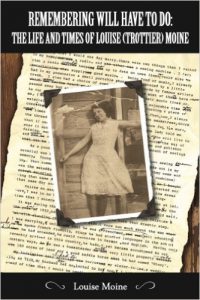Louise (Trottier) Moine

In her memoir of her years as a student at the Qu’Appelle school in the early 20th century, Louise (Trottier) Moine[1] wrote of her memory during a tuberculosis epidemic:
“There was a death every month on the girls’ side and some of the boys went also. We were always taken to see the girls who had died. The Sisters invariably had them dressed in light blue and they always looked so peaceful and angelic. We were led to believe that their souls had gone to heaven, and this would somehow lessen the grief and sadness we felt in the loss of one of our little schoolmates.”[2]
Of their diet, Louise Moine wrote,
“Although the boys milked cows, we never ate butter or drank whole milk. It was common knowledge that the butter was being sold to the villagers. Why was it sold when the children went without? The priests and nuns ate butter. Even though the children complained among themselves, it didn’t change matters any.63″[3]
Moine describes the clothing they wore:
“We wore black stockings that were made on a knitting machine, operated by hand by the older girls who worked in the sewing room. We all dressed alike in loose fitting ‘menage’ dresses during the week and our dress-up clothes on Sunday. We usually wore aprons for work. Our hair was braided and rolled back. We wore little black veils on our heads while at chapel during the week, and wore white ones on Sunday.18” [4]
Louise Moine recalled that at the Qu’Appelle school, “the teachers were very strict about segregation. So the boys kept to their side and we to ours. I can’t speak for the teenagers but, we, the younger members, were quite satisfied with these regulations.”32 One nun at the Qu’Appelle school noticed that Louise Moine often stared at a young male student and asked her if she liked the boy. When Louise said that she did, “Sister Cloutier, in her understanding way, proceeded to give me a few pointers on the facts of life. I felt affection for the first time in that school. I shall always remember her.”42[5]
Moine recalled: There was one little nun who was a full blooded Indian. She was gifted and talented and did most of the oil painting required in the school. I remember the roses and rosebuds she painted on the wide white ribbons that we wore as “Children of Mary.” It was a delicate work of art. She also did all types of handwork and taught handicrafts to the girls such as crocheting, embroidery and beadwork.381[6]
Moine recounted an incident in which a student complained to her parents about being strapped. The girl’s mother “marched right down to the playroom where she confronted the Sister by shaking her fist at her and telling her off in Sioux. The Sister, fearing abuse, held her cross up in front of the woman but she knocked it out of the Sister’s hand.”39[7] Louise Moine recalled being strapped for speaking back to a teacher when she attended the Qu’Appelle school in the early twentieth century.
She took me into the bathroom where she strapped me so hard that she got red in the face. What irritated her the most was that I wouldn’t cry. I was as stubborn as they come. When she stopped for air, I threw in an apology (not that I meant it). She stopped then and kissed me, but the damage had been done. As she had strapped on the seat, I couldn’t sit down properly and I couldn’t stand anything touching my behind for a while.86[8]
________________________________________
[1] Moine, L. (2013). Remembering Will Have to Do: The Life and Times of Louise (Trottier) Moine. Gabriel Dumont Institute.
[2] Truth and Reconciliation Commission. (2015). Canada’s Residential Schools: Missing Children and Unmarked Buriels, Vol. 4, p. 2
[3]TRC. (2015). Canada’s Residential Schools: The History, Part 1, Origins to 1939. The Final Report of the Truth and Reconciliation Commission of Canada, Volume 1, Part 1, p. 496
[4]TRC. (2015). Canada’s Residential Schools: The History, Part 1, Origins to 1939. The Final Report of the Truth and Reconciliation Commission of Canada, Volume 1, Part 1, p. 513
[5]TRC. (2015). Canada’s Residential Schools: The History, Part 1, Origins to 1939. The Final Report of the Truth and Reconciliation Commission of Canada, Volume 1, Part 1, p. 649
[6] TRC. (2015). Canada’s Residential Schools: The History, Part 1, Origins to 1939. The Final Report of the Truth and Reconciliation Commission of Canada, Volume 1, Part 1, p. 732
[7] TRC. (2015). Canada’s Residential Schools: The History, Part 1, Origins to 1939. The Final Report of the Truth and Reconciliation Commission of Canada, Volume 1, p. 523
[8] TRC. (2015). Canada’s Residential Schools: The History, Part 1, Origins to 1939. The Final Report of the Truth and Reconciliation Commission of Canada, Volume 1, p. 529